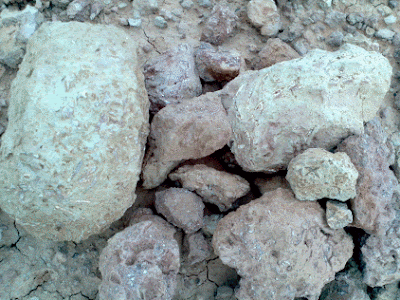Lysorophus at Area 51 Field Notes

Saturday, March 31st, 2011
Lysorophus: Permian (287 million years ago) burrowing carnivorous amphibian. They would estivate to escape the heat and the dry season. At this site they are found varying in shape and size, curled up in half donut looking burrows. Lung fish and a jaw (may be sillerpeton or Phlegethontia) in same area.
 |
| Lysorophus skeletons curled inside semi-donut shaped burrows |
The first bone found at site Area 51 was actually a neural spine bit from a larger amphibian called Eryops, a carnivore with primitive ear drums. The piece of neural spine was approximately two inches long, lying completely exposed on the east side of Area 51. I spotted the neural spine on my way back to join Dr. Bakker after visiting an "Adventure Bush". Many other bone bits from Eryops were found with the neural spine. A bit further from the Eryops remains appeared to be rocks scattered all over the hill. After taking a closer look, each of these rocks were full of fossilized skeletons of the little critter lysorophus. Tens of thousands of lysorophus are preserved at this site! All clearly visible at the surface! There are more bones than rocks at this site! In each donut, you can see the articulated vertebrae and ribs and bits of the skull! Everywhere you stepped, every rock you picked up, BONES! All spiraled in their burrows and frozen in time, these snake-like amphibians died waiting for the rains to end the Permian drought 287 million years ago.
 |
| Dr. Bakker at site Area 51 |
 |
| This is was the first bone found at site Area 51, a neural spine bone bit most likely from an amphibian called Eryops |
 |
| More Eryops bone bits at Area 51 |
 |
| Lysorophus Skull |
Now why exactly did I name this site Area 51? I did so because the name itself is so mysterious. I never expected to find the world's largest pocket of lysorophus. There are so many questions about this gathering of amphibians just as there is about Area 51. Even the little lysorophus almost look alien with their elongated bodies and tiny limbs.




Comments
Post a Comment